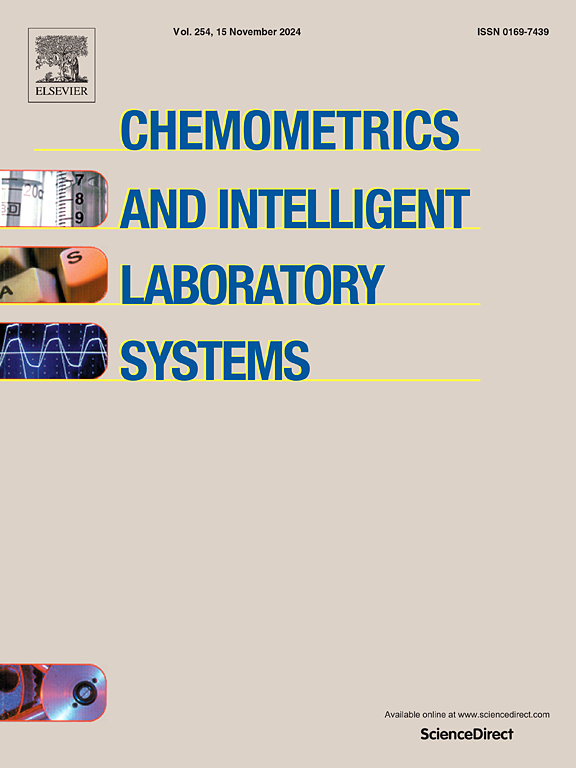Uncertainty of predictions in absorption spectroscopy: Modelling with quantile regression forest
IF 3.8
2区 化学
Q2 AUTOMATION & CONTROL SYSTEMS
Chemometrics and Intelligent Laboratory Systems
Pub Date : 2025-07-04
DOI:10.1016/j.chemolab.2025.105473
引用次数: 0
Abstract
Machine learning modelling is becoming popular for estimating agricultural and environmental properties from their infrared spectra. Commonly in modelling with machine learning and in commercial software applications, however, uncertainty estimates of the prediction are seldom reported. Uncertainty quantification of variables predicted with infrared spectroscopy is yet highly relevant in a number of applications, such as in uncertainty propagation analyses studies or for drug exposure detection. In this paper, we report on the development and application of quantile regression forest to predict properties from infrared spectroscopic data along with a sample-specific estimate of the uncertainty. Quantile regression forest is a machine learning algorithm that builds on random forest and provides estimate of the mean but also of the full conditional distribution of the predicted variable. We illustrate the algorithm with two chemometric applications and evaluate the modelling approach for its ability for predict the variable of interest and quantify the uncertainty. Evaluation involved usual validation statistics but also the validation of the uncertainty with the prediction interval coverage probability calculated for various interval widths. We tested prediction and prediction uncertainty quantification of two soil properties (cation exchange capacity and total organic carbon) as well as the dry matter of mango. The results confirm the potential of quantile regression forests for prediction and uncertainty quantification of properties predicted from infrared spectroscopy data. In all cases, the predictions were accurate and sample-specific estimates of the uncertainty were obtained. Validation of the uncertainty showed that the interval width was too large, thus overestimating the uncertainty for most intervals. Nevertheless, we recommend its use for operational applications as well as in future software developments, in particular when the data inferred by the spectroscopic model are used in other applications.
吸收光谱预测的不确定性:分位数森林回归模型
机器学习建模在从红外光谱估计农业和环境特性方面正变得越来越流行。然而,通常在机器学习建模和商业软件应用中,预测的不确定性估计很少被报道。红外光谱预测变量的不确定度量化在许多应用中仍然高度相关,例如不确定度传播分析研究或药物暴露检测。在本文中,我们报告了分位数回归森林的发展和应用,以预测红外光谱数据的性质,并对样本的不确定性进行了估计。分位数回归森林是一种机器学习算法,它建立在随机森林的基础上,提供了对预测变量的均值和完整条件分布的估计。我们用两个化学计量学应用来说明该算法,并评估其建模方法预测感兴趣变量和量化不确定性的能力。评估既包括通常的验证统计,也包括不确定性的验证,并计算不同区间宽度下的预测区间覆盖概率。对两种土壤性质(阳离子交换容量和总有机碳)以及芒果干物质进行了预测和预测不确定度量化试验。结果证实了分位数回归森林对红外光谱数据预测的特性进行预测和不确定性量化的潜力。在所有情况下,预测都是准确的,并且获得了特定样本的不确定性估计。不确定度的验证表明,区间宽度过大,从而高估了大多数区间的不确定度。然而,我们建议将其用于操作应用程序以及未来的软件开发,特别是当光谱模型推断的数据用于其他应用程序时。
本文章由计算机程序翻译,如有差异,请以英文原文为准。
求助全文
约1分钟内获得全文
求助全文
来源期刊
CiteScore
7.50
自引率
7.70%
发文量
169
审稿时长
3.4 months
期刊介绍:
Chemometrics and Intelligent Laboratory Systems publishes original research papers, short communications, reviews, tutorials and Original Software Publications reporting on development of novel statistical, mathematical, or computer techniques in Chemistry and related disciplines.
Chemometrics is the chemical discipline that uses mathematical and statistical methods to design or select optimal procedures and experiments, and to provide maximum chemical information by analysing chemical data.
The journal deals with the following topics:
1) Development of new statistical, mathematical and chemometrical methods for Chemistry and related fields (Environmental Chemistry, Biochemistry, Toxicology, System Biology, -Omics, etc.)
2) Novel applications of chemometrics to all branches of Chemistry and related fields (typical domains of interest are: process data analysis, experimental design, data mining, signal processing, supervised modelling, decision making, robust statistics, mixture analysis, multivariate calibration etc.) Routine applications of established chemometrical techniques will not be considered.
3) Development of new software that provides novel tools or truly advances the use of chemometrical methods.
4) Well characterized data sets to test performance for the new methods and software.
The journal complies with International Committee of Medical Journal Editors'' Uniform requirements for manuscripts.

 求助内容:
求助内容: 应助结果提醒方式:
应助结果提醒方式:


